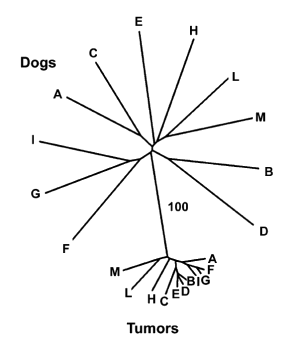A Transmissible Parasitic Cancer Discovered
In a recent article in the journal Cell, scientists from University College London and the University of Chicago have demonstrate conclusively that the cancer cells themselves are the contagious agent of canine transmissible venereal tumor (CTVT), commonly known as Sticker’s sarcoma.
While other cancers have been shown to be contagious through viruses, in this case, the tumor itself is spreading between individual canines—it is as if the cancer is metastasizing parasitically between individuals.
The genomes of the cancer cells are different from those of their hosts and are more closely related than those of even the most in-bred dog breeds, implying that the mutation emerged relatively recently.

Chord distance graph, showing the relative genetic distance between individual canines and their respective tumor cells.
Using genetic analysis, the authors show that the cancerous cells from any individual tumor are clones of a single malignant cell that mutated between 250 and 2500 years ago.
While this estimated date indicates a relatively recent evolutionary origin, CTVT represents the oldest known mammalian somatic cell in continuous propagation, having undergone countless mitoses and host-to-host transfers.
The mutated cell attained the ability to metastasize into a new host without initially being attacked by the host’s immune system and survive long enough to infect again.



is it possible that ocular toxocariasis could be a cause or reason for polycythemia?
» Posted by Anonymous on September 28, 2010 01:16 AM